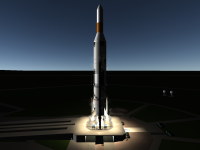
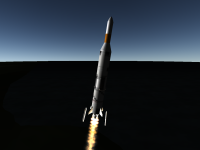
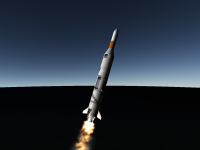
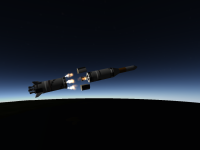
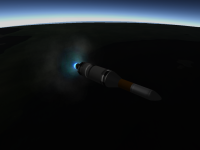
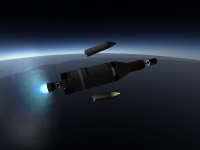
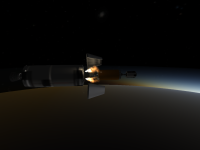
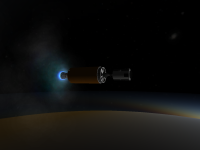
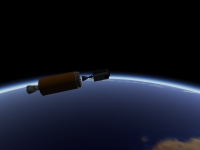

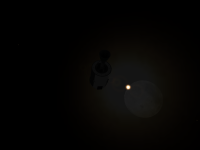

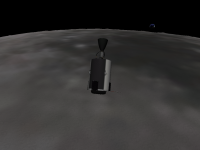


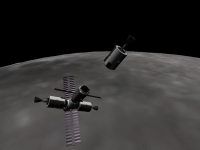
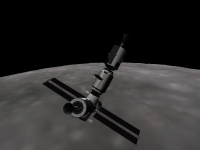
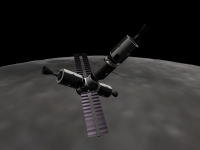
TLF-4 / LSE-1 was a manned lunar landing using the Delta Taxi Mk II (callsign "Deliverance") and the "Frontier" lander in conjunction with the Napier 1 spaceplane (mission NTF-13). The multiple-launch architecture also involved a CDEDS, and made use of the Legendre Space Station in LEO at 400km/28.6°, as well as the Lebesgue Propellant Depot in LLO.
This 'D-class' lunar mission followed the 'C-class' TLF-3 orbital mission the previous year, and used the same Delta Taxi vehicle for the crew transit between the Earth and Moon, it having been parked at Legendre in the meantime.

CONOPS diagram for this D-class lunar landing mission.
Though not truly a part of the TLF-4 campaign, we here include an example of a propellant delivery to Lebesgue. Barrow II.4, bringing about 3 tons of storable hypergolic propellants (50-50 and NTO) to the lunar-orbiting depot, launched on Euler Ac10 on March 24th, 1965 (before most of the C-class TLF-3 mission). The Euler Ac is a variant of the Euler A with a pair of Castor II solid strap-on boosters to augment the quad-H1B first stage.
The first launch of the campaign, on the 7th of February 1966, was Leibnitz DE10, carrying the single-stage reusable lander, callsign Frontier, to LLO to dock with Lebesgue Propellant Depot. The lander, essentially identical to the one test-flown as Experiment on LPF-1a, has a total ΔV capacity of just over 5km/s; however, to fit within the TLI throw mass of the Leibnitz-Centaur launch vehicle, it was launched with only a partial propellant load giving about half that capability. This was more than enough to brake into LLO and dock with Lebesgue, where its tanks were filled up for the landing from the stock already present there.
The Leibnitz DE10 launch vehicle is very similar to the ’DE9 used to launch Deliverance during the C mission.
Napier 1, a two-man spaceplane with 2km/s of orbital insertion/manœuvring capability from its XLR81-BA-13 engine, launched for NTF-13 at 2114Z on April 21st 1966, atop the Leibnitz DH15 booster (incorporating the lightweight tanks which have been proved on several unmanned Leibnitz launches, as well as the more reliable RS-27 booster engines).
The crew of the Napier were Arkady Lukashenko (pilot) and Brian Newman (passenger). This crew previously flew together on NTF-6 (taking Brian to meet Wayfarer for TLF-1) and have also both separately made trips to Legendre Space Station; this is Brian's fifth spaceflight and Arkady's third.
The spaceplane docked to the aft port of Legendre at T+2h50m, just after the calendar turned over to April 22nd.
CDEDS 4 was launched by Euler A+13 on the 22nd of April, 1966. The Euler A+ is a new upgrade to our Euler heavy-lift launch vehicle, using the simplified and uprated J-2S engine (256klbf) on the upper stage and replacing the H-1 engines on the booster with RS-27s for improved reliability. The CDEDS, meanwhile, incorporates upgrades of its own, using the RL10A-3-3A engine with its 9½% extra thrust.
After nearly six hours of manœuvring, at 0317Z on the 23rd, the CDEDS was docked with Deliverance in the vicinity of Legendre.
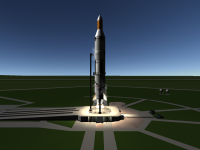 |
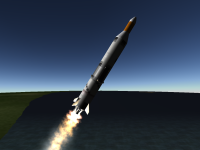 |
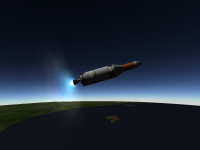 |
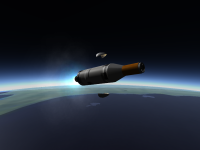 |
| Lift-off of Euler A+13 | Passing through Max-Q | After staging | Dropping fairings |
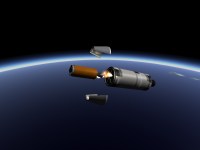 |
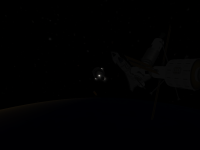 |
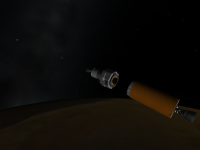 |
 |
| Payload separation at 0229Z | Taxying across to the CDEDS | Lining up the docking ports | TLF-4 stack fully assembled |
At 0350Z on the 23rd of April, Brian Newman, piloting the TLF-4 stack of Delta Taxi Mark II Deliverance and CDEDS 4, commenced the translunar injection burn, firing the RL10A-3-3A engine of the CDEDS for 387 seconds to supply 3,126m/s of ΔV at an acceleration ranging from 0.59g to 1.2g.
At 0408Z he undocked from the CDEDS, then made a 2m/s RCS TCM at 0413Z, refining periselene to 80km.
Deliverance arrived in lunar space 50 hours later, at 0506Z on April 25th.
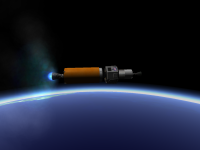 |
 |
 |
| TLI burn on the RL10A-3-3A | Undocking from the CDEDS | Drifting slowly apart |
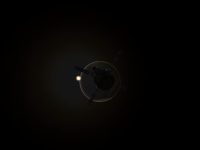 |
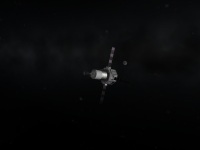 |
 |
| Sun setting behind receding Earth | Getting nearer the Moon | Into the lunar SoI |
The 859m/s LOI burn began at 1932Z on 25th April, and lasted for 85 seconds, placing Deliverance in a 419×80km orbit with a 2’ RI to Lebesgue Propellant Depot. Following a 4m/s RCS burn at 2251Z and a 65m/s burn on the main engine at 2358Z, the orbit was 98×97km and led to a rendezvous at 0037Z on the 26th, above Mare Crisium. Five minutes later the docking was completed.
Propellant and life-support supplies were pumped across from the Depot to the Taxi.
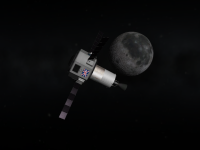 |
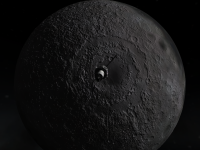 |
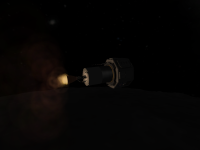 |
 |
| Falling towards periselene | Passing over Mare Orientale | Braking into lunar orbit | Sun rising after Earth |
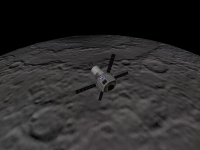 |
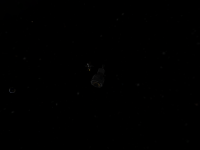 |
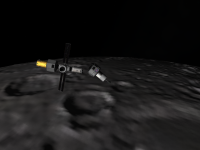 |
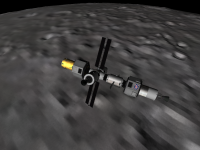 |
| In low orbit around the Moon | Lebesgue sighted | Approaching the aft port | Docked with the Depot |
Mare Serenitatis was chosen as the target site for the landing, and Brian, now in Frontier, undocked from Lebesgue at 0142Z, before making a 16m/s burn at 0150Z to brake down to 98×25km orbit. The descent began at 0240Z, the lander engine initially producing a mere 0.27g of acceleration. Twelve minutes later, 0252Z on the 26th of April 1966, for the first time a manned vessel touched down on the surface of the moon as Frontier landed softly at 30°4’N 19°2’E, having used some 2,200m/s of ΔV (leaving just over 2,800m/s in the tanks for the ascent).
 |
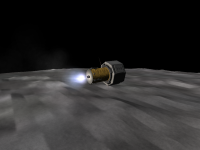 |
 |
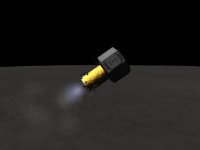 |
| Separation from Lebesgue | GO for powered descent | Guided down by konrad | Landing legs deployed |
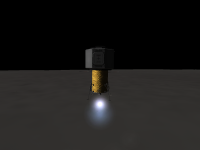 |
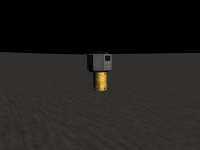 |
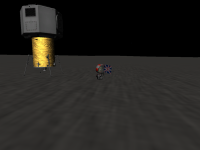 |
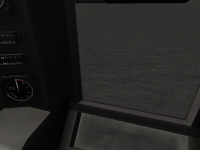 |
| Descending vertically | Touchdown in the Sea of Serenity | Well, do you have a flag? | View from Frontier's cabin |
After 3 hours 47 minutes on the lunar surface, Frontier restarted its engines at 0639Z to climb to orbit, chasing the Lebesgue Propellant Depot as it passed overhead. It took the lander five minutes to reach 101×17km lunar orbit (with a 9’ relative inclination to the Depot) with the acceleration reaching almost 1g as the tanks drained. After a series of orbital manœuvres, Frontier reached Lebesgue and redocked at 1022Z; the propellant tanks still held enough for another 69 seconds at full throttle (over 750m/s of ΔV), a reassuringly large margin.
Brian Newman then EVAed across from the lander to the Taxi Deliverance, bringing with him the rock samples he had collected on the surface.
After undocking from Lebesgue, Deliverance made a 799m/s TEI at 1123Z, lasting 80½ seconds. At the completion of this burn, the Taxi was on course for a 225km perigee at the end of its 4½-day transfer. The trajectory had been carefully calculated to arrive with a suitable phase angle to Legendre Space Station.
The Moon's SoI was exited at 0612Z on April 27th, and Deliverance spent the remainder of the month of April falling back towards Earth. The ERB manœuvre, a 170-second burn of the ERPS, commenced at 0116Z on the 1st of May. Peaking at 3.1g, it slowed the Taxi by 3,049m/s and placed it in a 501×223km orbit, inclined at just 50” relative to Legendre Space Station. This was followed by a five-second burn at 0220Z of 152m/s, which brought Deliverance to 402×397km at a distance of 1.6km from Legendre. At 0251Z Deliverance was safely docked to the Station, with margins of about 50m/s of ΔV and 3½ days of life-support.
With Brian and his rocks safely aboard Napier 1, at 0254Z Arkady Lukashenko undocked the spaceplane from Legendre Space Station and manœuvred clear, using the HTP RCS thrusters to lower the orbit to 399×380km. After waiting for the Cape to roll under the orbital track, at 1910Z a 157m/s deorbit burn put the Napier onto a 380×-49km trajectory.
The spaceplane hit entry interface at 1935Z and crossed the Kármán line at 1937Z. By 1956Z it was subsonic, having experienced no more than 1⅔g all the way down; in fact, the crew sustained more g-forces making turns in the circuit as Napier glided down to the runway approach. At 2003Z, Napier was safely down, parked on the apron at KSC.
With flag and footprints on the Moon, and the safe return of the astronaut who left them there, the key goals of the TLF mission series have been achieved. In future I plan to fly more C- and D-class missions and perhaps develop larger vehicles capable of multi-man trips; eventually Lebesgue may develop into (or be replaced by) a fully-fledged space station in lunar orbit. Meanwhile, probes to visit the outer planets and return Martian soil samples should keep me busy for a while.
It's also time to start serious work on a new spaceplane to replace the aging Napiers; changes in the laws of thermodynamics have made re-entry harder and Napier is now a very marginal design.
Longer term, I am beginning to think about how interplanetary missions might be performed; however, it seems very unfeasible to do them without aerobraking, as the ΔV requirements become staggering. At the very least I'll need to be able to store cryogenic propellants in space, and realistically it would be far more sensible to use a capsule for the return to Earth, rather than trying to propulsively brake from interplanetary transfer velocity. But then, this lunar landing seemed pretty crazy too when I was first sketching the idea of 'translunar taxis', and it turned out to be eminently workable. Who knows what the future may hold?